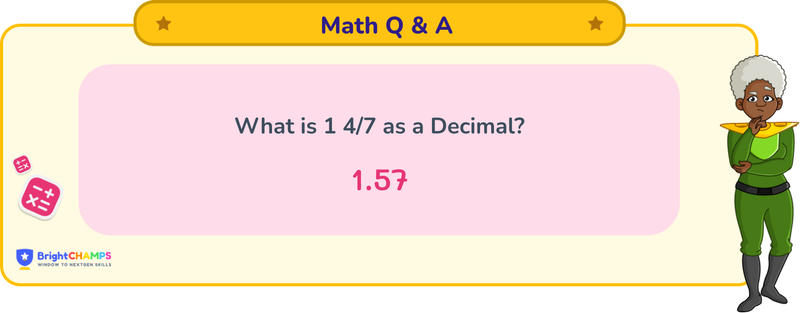
 132 Learners
132 LearnersLast updated on May 26th, 2025

1 4/7 as a Decimal

It is a simple question on decimal conversion. Firstly, we have to learn fractions and decimals. A fraction represents a part from the whole. It has two parts, numerator (number on the top) here, 1 represents the whole part and 4 which represents how many parts out of the whole 7. The denominator (number below) shows how many parts make the whole, here it is 7. A decimal is a way to represent the number that is not whole, using a (.) or a decimal to separate the whole part from the fraction part. The numbers to the left of the decimal point represent the whole, and that to the right represents the fractional part.
What is 1 4/7 as a decimal?

Answer
1 4/7 in decimals can be written as 1.5714285….. It is a non-terminating decimal, showing that the digits after the decimal point repeat in a sequence.
Explanation
To convert 1 4/7 to a decimal, we will use division for the fractional part. The whole number 1 remains as is. Here’s the step-by-step breakdown of the process:
Step 1: Identify the fractional part, which is 4/7.
Step 2: Divide the numerator (4) by the denominator (7) to convert the fraction to a decimal.
Step 3: As 4 is smaller than 7, we need to use decimal division. Place a decimal point in the quotient and add zeros to the dividend.
Step 4: Divide 4 by 7, which gives approximately 0.5714285, a repeating sequence.
Step 5: Combine the whole number with the decimal part to get 1.5714285. The process of division shows that 4/7 is 0.5714285 repeating, and the final answer for 1 4/7 as a decimal is 1.5714285.
Struggling with Math?
Get 1:1 Coaching to Boost Grades Fast !

Important Glossaries for 1 4/7 as a decimal
- Mixed Number: A combination of a whole number and a fraction.
- Fraction: A numerical quantity that is not a whole number, representing a part of a whole.
- Decimal: A number that uses the base ten and includes a decimal point to separate the whole part from the fractional part.
- Numerator: The top part of a fraction, indicating how many parts of the whole are being considered.
- Non-terminating Repeating Decimal: A decimal in which a sequence of digits repeats infinitely.




